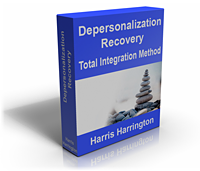Harris Harrington addresses a very basic, yet somewhat complicated question.
 Depersonalization disorder confuses many people. Many people think it is simply anxiety, or merely a symptom of panic disorder.
Depersonalization disorder confuses many people. Many people think it is simply anxiety, or merely a symptom of panic disorder.
There is no question that most people with DPD also have panic disorder and generalized anxiety, yet the feelings of dissociation that go along with DP are not experienced by most sufferers of anxiety.
Transient, or short lived depersonalization is definitely a common symptoms of anxiety and panic, but not long lasting, or chronic DP. Chronic DP is different.
Depersonalization Disorder is a Result of Complex Trauma
In order to understand DPD I like to compare it with the most similar anxiety disorder: PTSD (Post-Traumatic Stress Disorder).
PTSD occurs when someone witnesses a traumatic event, such as a car accident, a battle, a murder, etc. What occurs in the brain of a PTSD victim is that excess stress hormones flood the brain and actually kill brain cells in a certain area responsible for putting the “brake” on the stress response. This area of the brain is known as the hippocampus. The hippocampus tells your stress response to calm down. If your hippocampus is damaged, then it will be difficult to calm down after you hear something that startles you.
People with PTSD experience extreme anxiety and panic in situations that resemble the traumatic event they have experienced.
Depersonalization is similar to PTSD in that DP is caused by traumatic memories. The difference is in the type of trauma experienced. In DPD, the trauma is not a specific, extremely traumatic event, but rather an accumulation over a long period of time of more mild trauma in the form of stressful life situations. This is called complex trauma. The C-PTSD category was first created by a Harvard psychologist Judith Herman back in the 1980s.
Studies have shown that the number one factor that predicts the onset of DP is emotional abuse in childhood and adolescence.
DP and Anxiety
Frankly, it doesn’t matter if you consider DP an anxiety disorder. Afterall, PTSD is technically an anxiety disorder, but it’s still different from the other anxiety disorders in terms of what causes it. My opinion is that DPD falls into a complex post traumatic category.
In many ways DP resembles anxiety, and treating the anxiety aspects of DP will definitely help relieve the disorder. However my opinion is that it’s important to do some additional trauma work (in terms of processing the past) in combination with any cognitive and behavioral therapy for treating the anxiety.
Emotions and DP
It makes sense that emotional abuse is so common in people with DP. Emotions are a bridge between our mind and our body. If we experience something so painful for long enough, our body numbs our emotions. It’s pretty simple. It’s a protective mechanism.
In DP its extremely important to get in touch with how we are feeling. There is a lot of gold there.
Given this knowledge of DP, here are some steps I recommend to people that want to recover:
1. Practice guided relaxation daily until it becomes second nature
2. Expose yourself to the uncomfortable feelings of DP and any situation that triggers your anxiety.
3. Practice emotional expression about situations in the present, and feelings you’ve suppressed in the past, particularly emotions you feel towards certain people. This can be in the form of writing or in conversations.
4. Journal about your past. I recommend reading books like Nina Brown’s Children of the Self Absorbed, or any good book on dysfunctional families and attachment theory. Understand the family you have come from. This may take some work, and you may want to seek the help of a psychodynamic therapist to help you process your past (just make sure you have a premium health insurance plan before you do so).
These are very general guidelines for recovery. My advice for recovering from DP is to follow an integrative approach, meaning that it is important to draw from many different schools of thought. Attachment Theory, Acceptance and Commitment Therapy, Cognitive Behavioral Therapy, and Dialectical Behavior Therapy are four approaches that all should be studied.
